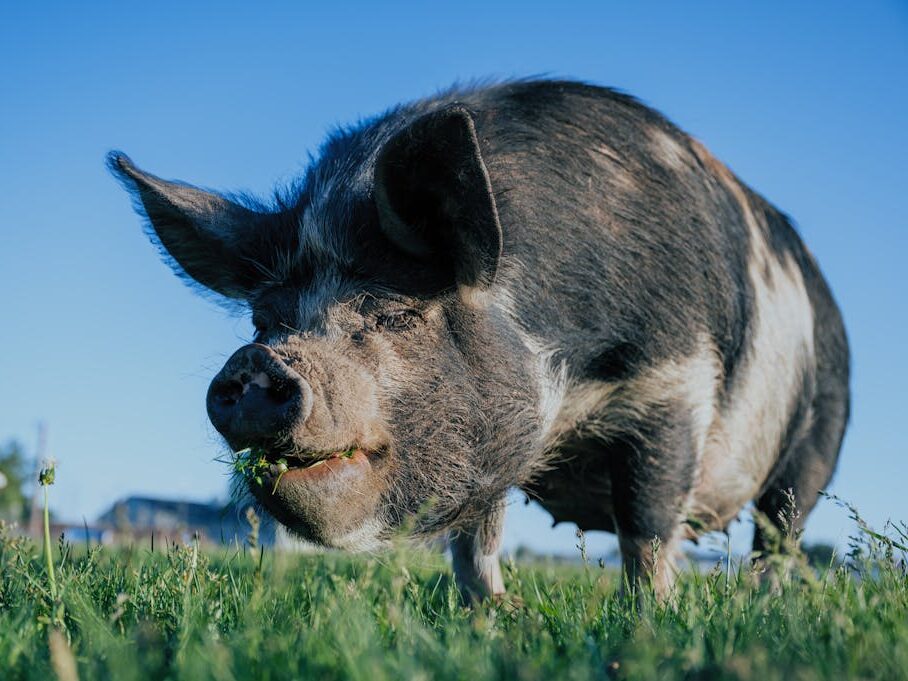
Pigs
From initial registering your pigs through to the final product packaging and labelling.
Updated 7 June 2024
Transport & slaughter
Transporting pigs
If you transport pigs to your farm/croft or take them elsewhere in a vehicle, you have a legal responsibility to ensure their welfare during transit. You must also notify ScotEID and print movement documents to accompany the pigs if required (see ‘Moving pigs’).
There are also limitations on what animals you can transport and how far. For example, you cannot transport ill or heavily pregnant pigs. Farm Advisory Service has published a guide on your legal duties in transporting animals.
You must never tether pigs for transport.
Transporting pigs yourself
If you sell pork from your herd, you are considered to be transporting pigs for ’commercial purposes’ and must comply with relevant regulations. You are exempt if you are transporting the pig to a vet or for a journey that is under 50km, in your own vehicle. Otherwise you will need authorisation (see ’Approvals’).
To transport pigs, you will need a livestock trailer with some bedding.
After transporting pigs, you must clean and disinfect your vehicle after unloading. You must do this within 24 hours of before using the vehicle to transport pigs/livestock again, whichever comes first.
Read more about your legal duties on animal welfare during transport (this guidance also applies to Scotland).
Read more:
- Livestock transport: an information and training package, Quality Meat Scotland
- ’Transport of livestock’, Humane Slaughter Association
- ‘Welfare of commercial animals in transport’, Scottish Government
- The Welfare of Animals (Transport) (Scotland) Regulations 2006
Approvals
If you transport pigs more than 65km, you will need to apply for two types of approvals. There are different requirements for both approvals depending on whether the journey is under or over 8 hours.
- Drivers need a Certificate of Competence (CoC) which confirms that they know how to transport animals responsibly. CoC is not required for journeys to the vet. You need a different CoC for every type of livestock you transport. NPTC City & Guilds Assessment Centre and Lantra organize CoC courses.
- Your farming/crofting business needs a Transporter Authorisation. Contact APHA Welfare in Transport team for an application pack – the authorisation is valid for 5 years.
If the journey is over 8 hours, you must also get your vehicle and containers approved. This approval is valid for 5 years, and you can find details of certifying bodies on APHA website.
Read more:
Using a transporter company
If you use a transport business, you should check that they hold the right authorisations to transport pigs. Instructions for how to check on APHA website.
Slaughtering pigs
Pigs are usually sent to slaughter at 6-10 months depending on their breed, weight and what kind of meat you want to produce (see also ’Preparing meat’).
- Porker – Pig reared for pork, ready at 4-6 months old/around 60kg weight.
- Cutter – Pig reared for larger cuts, between porkers and baconers in age and weight.
- Baconer – Pig reared for bacon, ready at 8-10 months old/80-100kg in weight.
Check how to measure pig weight.
To sell meat from your pigs, you must send them to be slaughtered in an abattoir. It is illegal to sell meat that has not been slaughtered in an approved abattoir.
Do not slaughter or send for slaughter pigs that are ill or have just received medication – you must wait until the end of the withdrawal period (see ’Medicines’).
Abattoirs/slaughterhouses
You must use an abattoir approved by Food Standards Scotland (FSS), or you cannot sell the pork – see the list of approved abattoirs. If your pork is certified organic, you must send the pigs to an organic abattoir which can be difficult in Scotland. See a non-exhaustive list of organic abattoirs in the UK.
If you are organic, you need to use an abattoir which is organically certified
It is a good idea to ask for abattoir recommendations from your farming/crofting contacts.
When booking the abattoir:
- Book a slot well in advance, as many abattoirs book up weeks or months ahead.
- Check where their offloading ramp is, so you know how to get there.
- Confirm whether the carcasses will delivered to you or a butcher.
- Prepare your movement documentation (see ’Moving pigs’) and Food Chain Information (FCI) declaration, which will be given to you by the abattoir. A model FCI declaration is available on Food Standards Scotland.
Before sending pigs to an abattoir:
- Check that they are correctly marked (see ‘Marking pigs’).
- They must be reasonably clean to comply with meat hygiene standards.
Find out more:
- ’5.1. Abattoirs’, in the Soil Association guide to small scale pig keeping
- ’Preparing for slaughter’, Accidental Smallholder
- ’At the abattoir’, Accidental Smallholder
- ’Slaughter’, Small-scale pig farming (Canadian site)
Home slaughter
You do not need a licence to slaughter your own pigs if the meat is for your immediate household’s consumption only. You cannot sell home slaughtered pork or, for example, offer it to bed and breakfast guests.
In home slaughter, only you can kill the animal and this must be done on your farm/croft.
It is illegal to cause avoidable suffering to an animal when slaughtering it, and pigs must remain unconscious until death. Get training from course providers like the Humane Slaughter Association (HSA).
HSA has published a useful guide for home slaughtering livestock for consumption, which covers both your legal duties and the practicalities of slaughtering animals.
Read more: